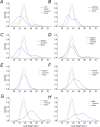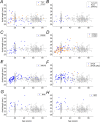Axial Length Distributions in Patients With Genetically Confirmed Inherited Retinal Diseases
- PMID: 35704304
- PMCID: PMC9206393
- DOI: 10.1167/iovs.63.6.15
Axial Length Distributions in Patients With Genetically Confirmed Inherited Retinal Diseases
Abstract
Purpose: We investigated axial length (AL) distributions in inherited retinal diseases (IRDs), comparing them with reference cohorts.
Methods: AL measurements from IRD natural history study participants were included and compared with reference cohorts (TwinsUK, Raine Study Gen2-20, and published studies). Comparing with the Raine Study cohort, formal odds ratios (ORs) for AL ≥ 26 mm or AL ≤ 22 mm were derived for each IRD (Firth's logistic regression model, adjusted for age and sex).
Results: Measurements were available for 435 patients (median age, 19.5 years). Of 19 diseases, 10 had >10 participants: ABCA4 retinopathy; CNGB3- and CNGA3-associated achromatopsia; RPGR-associated disease; RPE65-associated disease; blue cone monochromacy (BCM); Bornholm eye disease (BED); TYR- and OCA2-associated oculocutaneous albinism; and GPR143-associated ocular albinism. Compared with the TwinsUK cohort (n = 322; median age, 65.1 years) and Raine Study cohort (n = 1335; median age, 19.9 years), AL distributions were wider in the IRD groups. Increased odds for longer ALs were observed for BCM, BED, RPGR, RPE65, OCA2, and TYR; increased odds for short AL were observed for RPE65, TYR, and GPR143. In subanalysis of RPGR-associated disease, longer average ALs occurred in cone-rod dystrophy (n = 5) than rod-cone dystrophy (P = 0.002).
Conclusions: Several diseases showed increased odds for longer AL (highest OR with BCM); some showed increased odds for shorter AL (highest OR with GPR143). Patients with RPE65- and TYR-associated disease showed increased odds for longer and for shorter eyes. Albinism genes were associated with different effects on AL. These findings add to the phenotype of IRDs and may yield insights into mechanisms of refractive error development.
Conflict of interest statement
Disclosure:
Figures





References
-
- Dolgin E. The myopia boom. Nature. 2015; 519: 276–278. - PubMed
-
- Ashby R, Ohlendorf A, Schaeffel F.. The effect of ambient illuminance on the development of deprivation myopia in chicks. Invest Ophthalmol Vis Sci. 2009; 50: 5348–5354. - PubMed
-
- Ashby R. Animal studies and the mechanism of myopia-protection by light? Optom Vis Sci. 2016; 93: 1052–1054. - PubMed
-
- Hendriks M, Verhoeven VJM, Buitendijk GHS, et al. .. Development of refractive errors-what can we learn from inherited retinal dystrophies? Am J Ophthalmol. 2017; 182: 81–89. - PubMed
-
- Tedja MS, Wojciechowski R, Hysi P, et al. .. Light processing and regulators are important mechanisms in refractive error. Invest Ophthalmol Vis Sci. 2017; 58: 1225.
Publication types
MeSH terms
Substances
Supplementary concepts
Grants and funding
LinkOut - more resources
Full Text Sources
Medical
Research Materials
Miscellaneous

